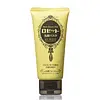What's inside
What's inside
 Key Ingredients
Key Ingredients

 Benefits
Benefits

 Concerns
Concerns

 Ingredients Side-by-side
Ingredients Side-by-side

Water
Skin ConditioningStearic Acid
CleansingSodium Cocoyl Glycinate
CleansingLauramidopropyl Betaine
CleansingGlycerin
HumectantHydroxypropyl Starch Phosphate
Cetearyl Phosphate
Skin ConditioningXylitylglucoside
HumectantDimethicone PEG-8 Meadowfoamate
EmollientAnhydroxylitol
HumectantXylitol
HumectantLeuconostoc/Radish Root Ferment Filtrate
AntimicrobialBromelain
Skin ConditioningPapain
Skin ConditioningLactobacillus/Pumpkin Fruit Ferment Filtrate
Skin ConditioningLauramide Dipa
Emulsion StabilisingAloe Barbadensis Leaf Juice Powder
Skin ConditioningLactic Acid
BufferingGlycolic Acid
BufferingCitrus Aurantium Bergamia Fruit Oil
MaskingAniba Rosaeodora Wood Extract
MaskingCitrus Aurantium Dulcis Peel Oil
MaskingGlucose
HumectantPelargonium Graveolens Flower Oil
MaskingCitral
PerfumingBenzyl Benzoate
AntimicrobialBenzyl Alcohol
PerfumingSodium Hydroxide
BufferingLimonene
PerfumingChlorphenesin
AntimicrobialLinalool
PerfumingCitronellol
PerfumingMaltodextrin
AbsorbentGeraniol
PerfumingCI 75810
Cosmetic ColorantWater, Stearic Acid, Sodium Cocoyl Glycinate, Lauramidopropyl Betaine, Glycerin, Hydroxypropyl Starch Phosphate, Cetearyl Phosphate, Xylitylglucoside, Dimethicone PEG-8 Meadowfoamate, Anhydroxylitol, Xylitol, Leuconostoc/Radish Root Ferment Filtrate, Bromelain, Papain, Lactobacillus/Pumpkin Fruit Ferment Filtrate, Lauramide Dipa, Aloe Barbadensis Leaf Juice Powder, Lactic Acid, Glycolic Acid, Citrus Aurantium Bergamia Fruit Oil, Aniba Rosaeodora Wood Extract, Citrus Aurantium Dulcis Peel Oil, Glucose, Pelargonium Graveolens Flower Oil, Citral, Benzyl Benzoate, Benzyl Alcohol, Sodium Hydroxide, Limonene, Chlorphenesin, Linalool, Citronellol, Maltodextrin, Geraniol, CI 75810
 Reviews
Reviews

Alternatives
Ingredients Explained
These ingredients are found in both products.
Ingredients higher up in an ingredient list are typically present in a larger amount.
Glycerin is already naturally found in your skin. It helps moisturize and protect your skin.
A study from 2016 found glycerin to be more effective as a humectant than AHAs and hyaluronic acid.
As a humectant, it helps the skin stay hydrated by pulling moisture to your skin. The low molecular weight of glycerin allows it to pull moisture into the deeper layers of your skin.
Hydrated skin improves your skin barrier; Your skin barrier helps protect against irritants and bacteria.
Glycerin has also been found to have antimicrobial and antiviral properties. Due to these properties, glycerin is often used in wound and burn treatments.
In cosmetics, glycerin is usually derived from plants such as soybean or palm. However, it can also be sourced from animals, such as tallow or animal fat.
This ingredient is organic, colorless, odorless, and non-toxic.
Glycerin is the name for this ingredient in American English. British English uses Glycerol/Glycerine.
Learn more about GlycerinWe don't have a description for Lauramidopropyl Betaine yet.